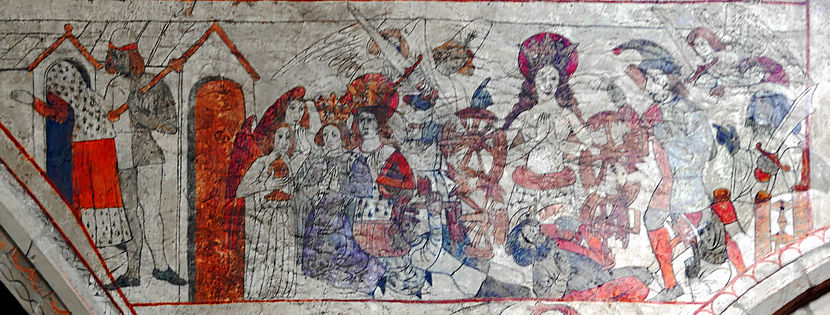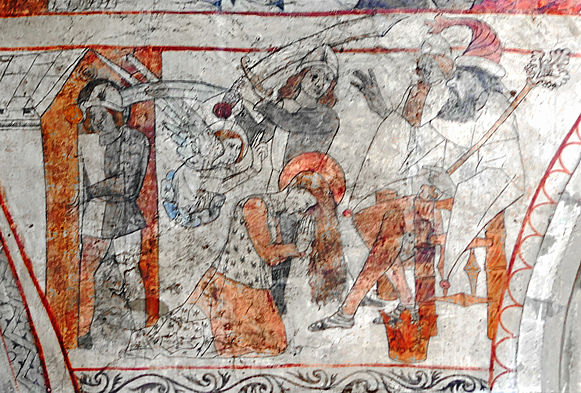Pickering, N Yorkshire (†York) C.15
The Life of St Catherine
The damaged example at Sporle apart, this is the fullest painted version of the Life of St Catherine of Alexandria in the English church. It is a very large painting, arranged in four tiers. The highest of these is shown below.

It begins at the furthest left, with the pagan idol-worship about which Catherine protested. The idol itself, which has upstanding hair resembling flames and holds what looks like a spiked club, stands on a red plinth. Next to it is another, slimmer, plinth, shown in its entirety. This is evidently a pagan altar – fire, presumably of sacrifice, burns on top of it, and various persons stand or kneel in adoration. Music on brass instruments, one of them an early trombone, recently evolved from the sackbut, accompanies the proceedings.

Further to the right, beyond the worshippers, Catherine, now condemned to prison, stands with hands clasped in prayer while the Emperor, holding his curved sword or falchion, presides from his throne. At the far right, with hand raised in protest, Catherine is dragged to prison.
In the next tier (below), Catherine, released from prison, disputes with the fifty philosophers sent by the Emperor to debate with her and converts them to Christianity instead. They are duly condemned and burnt, and further right, although there is no sign of the fire, a soldier with a lance and a ‘comedy’ hat corrals them into a squatting group, while another stands behind. In the approximate centre of this tier, Catherine is back in prison, just visible through the barred window of the narrow prison-house, while further right she is brought out and scourged, with the Emperor again looking on.

Thrust back into prison (right), Catherine is brought out again to be condemned with the now-converted Empress. Both women are shown kneeling, attended by angels, at the centre left. One angel holds a covered chalice or incense jar and something else, perhaps a book – both possibly symbolic of the new religion the Empress has embraced. Catherine appears again at the centre right, flanked by the four wheels with which she was tortured. Divine intervention broke them, and they are shown in fragments here, along with a number of fallen soldiers, felled by the exploding wheels, and the now-familiar figure of the Emperor.

The lowest tier is entirely taken up with the final scene in Catherine’s life, her beheading. Catherine kneels, her long hair over her face and her royal crown on the ground beside the Emperor’s chair. A hovering angel blesses her as the executioner raises his sword. The Emperor shares the authority-undermining headgear of his retainers; it shows well here, and his falchion is replaced by an elaborate sceptre.
Inscriptions are visible in the second tier of this painting, and the form of some of the letters (enlarged b/w detail below) suggests a mixture of Latin and late Middle English, something found elsewhere in the paintings at Pickering. So far as I know, no-one has yet deciphered these, and I can make out nothing with certainty, although the odd word or part of a word suggests itself here and there. Others may have more success, but it is hard to reproduce this kind of thing clearly on-screen.

There are many other paintings at Pickering. The fine St Christopher is newly on the site: also here are the Martyrdom of St Edmund (with a new photograph), the reorganised Seven Works of Mercy and the new Passion Cycle. The remaining subjects will be here soon.
Website for SS Peter & Paul, Pickering
Photos: Helge Klaus Rieder CC0